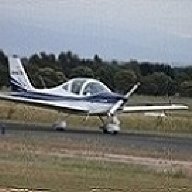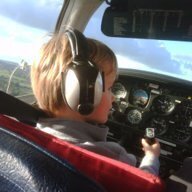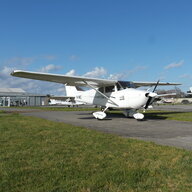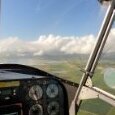-
Posts
459 -
Joined
-
Last visited
-
Days Won
17
About F10
- Birthday 12/12/1960
Information
-
Aircraft
Gazelle tricycle gear
-
Location
Sale Victoria
-
Country
Australia
Recent Profile Visitors
F10's Achievements

Well-known member (3/3)
-
F10 started following 912 throttle response hesitation , Airliner tyre wear and 3 more gone too soon. Near Maffra 16/11/24
-
Yes Machii jets had low melting point (lead I think) plugs in the wheel rims, so overheating brakes would cause tyres to deflate, (melted plugs) rather than the tyre to melt/explode, far more dangerous. Aquaplaning in the Machii was unpleasant as you would use differential braking to steer, when rudder effectiveness had dropped off. But that would take some pretty deep water on the runway. There was a Utube clip of some interesting experiments done by NASA, running a Boeing 737 nose gear, in a concrete trough with different speeds and water depths. once up and aquaplaning, the wheel actually comes to a complete stop, as shown by the high speed camera. This leads to the water under the tyre turning to steam and burning the tyre. The Lear jet used engine bleed air to rotate the front wheel, as a still standing wheel would generate a bigger splash touching down, sending water right into the engine intakes. Some nose wheel tyres will have a ridge on the tyre wall, to deflect water. In Oman I noticed the Hawks would thump it down on the runway, a carrier type landings. I asked, and was told a soft gradual touchdown leading to lots of impressive looking smoke and drama as the wheel spun up, greatly increased their tyre wear. Made sense.
-
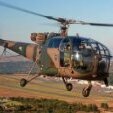
3 more gone too soon. Near Maffra 16/11/24
F10 replied to BirdDog's topic in Aircraft Incidents and Accidents
Yes! In addition, what is the effect of load factor? In a level 60 deg AoB steep turn, you need to hold 2g. To see the load factor effect, take the square root of your 2g load factor (1.4) and multiply 50 Kts Vref by 1.4, that gives you 70 Kts!! So wanging around in tight orbits…better bump up the safety speed! This is an exponential effect. A 4g turn will double your aircraft’s stall speed. -
These are Bing constant velocity carbs, opening the throttle butterfly will cause the slides to rise up, withdrawing the needle from the diffuser, letting more fuel into the venturi. Are the slides moving freely? Nev correct, the rubber diaphragms in the dashpots could be leaking slightly. If the slides don't rise up, you will have a short term leaning of the mixture. Consider cleaning carbs and renew needles and rubber diaphragms. Private message me, I can give you the contact details for two members of the Yarram Aero Club, who know a lot about Rotax 912 UL engines and Rotax engine tuning. Enjoy your Gazelle! I have one and have had an absolute ball flying mine! A fun and viceless little aircraft. And before we see posts making you feel less of a pilot, because of their claim that the Gazelle is soooo easy to fly it's almost not an aeroplane....like the famous and beloved Piper Cub, about which it is said "A Cub can almost kill you"....so too, disrespect it and the Gazelle (like any aircraft) can hurt you, badly.
-

3 more gone too soon. Near Maffra 16/11/24
F10 replied to BirdDog's topic in Aircraft Incidents and Accidents
Yes true, aerobatics below 500Ft its no mans land, no matter how good you are. But if you are calling stalling exercises aerobatics, think again. -

3 more gone too soon. Near Maffra 16/11/24
F10 replied to BirdDog's topic in Aircraft Incidents and Accidents
Thought this post was after the quoted one, but no, so this re-posting it. Well hell yes, however over 800 hours on Harvards in the military and countless stalls powering/off, g-stalls, incipient and full spin recoveries plus extensive aerobatics, and in a Skyfox Gazelle @ a MAUW of 520Kg’s, made me comfortable at 2000Ft agl. But yes, always stick to your comfort zone. -

3 more gone too soon. Near Maffra 16/11/24
F10 replied to BirdDog's topic in Aircraft Incidents and Accidents
Well yes, however over 800 hours on Harvards in the military and countless stalls powering/off, g-stalls, incipient and full spin recoveries plus extensive aerobatics, and in a Skyfox Gazelle @ a MAUW of 520Kg’s, made me comfortable at 2000Ft agl. But yes, always stick to your comfort zone. -

Zonsen Aero Engines - Rapture Aviation (Adelaide)
F10 replied to Rapture's topic in AUS/NZ General Discussion
Yes agree, 85 Kts is the start of the yellow arc. But it's not so much the speed, its the improved rate of climb and take off performance that would be good! -

3 more gone too soon. Near Maffra 16/11/24
F10 replied to BirdDog's topic in Aircraft Incidents and Accidents
That Saturday I took two young boys flying in my Gazelle, from West Sale. I saw the Cougar parked across the ramp in the grass. We had a fantastic time. Both boys said to me when coming in to land "This is the best day of my life!", too funny! They had a ball. I did the obligatory positive and negative G turn and gentle wingover, at 1500Ft, as much as you can do in a Gazelle. The one lad at the start, was a bit cautious, so asked if I could just fly around. I said absolutely, I will do exactly what you want me to do....But he soon was enjoying it and went for the gentle "G" demo...I got the "toy houses and cars" comment too! A week or two before I was up solo at 2000Ft, doing power on stalls and unbalanced stall....even a Gazelle will drop a wing! Can't get my head around that, literally a half hour after I departed, having put the Gazelle away, three young men went out in that Cougar and died!?? Makes me sick. The pilot had around 600Hrs? But what upset experience? This looked like a steep angle impact. It looks like a stall spin scenario? With 600 Hrs experience I like to think an engine failure should have resulted in a landing in a paddock, even a hard landing. But also could have been stalled in a forced landing. Terrible, terrible event...what price for experience?? My Air Force training, and experience are invaluable as they keep me safe. I've seen too many horror incidents. I am not a daring pilot, If there's a play.....I play it safe.... Aviation can be extremely brutal.....but I guess so are the teen hooning car crash tragedies? But again....is upset training and accelerated or "G" stalls; severely neglected these days? I think so. I walked out once I locked the hangar, and had a look at the Cougar. Must have as I said, just missed these guys....would I have maybe said something, chatted about the conditions (it was getting hot and was getting turbulent below 1500 Ft as was forecast. Would that have changed things? Probably not. Can't say I liked the Cougar proportions much..... it has a lot of keel area ahead of the wing, the engine being very far forward. The tailfin is small, just eyeballing it, I thought directional stability can't be great? Short span but broad chord wing. The winglets are large and may help with directional stability? -

Zonsen Aero Engines - Rapture Aviation (Adelaide)
F10 replied to Rapture's topic in AUS/NZ General Discussion
This could be interesting....like me, you can pick up a pretty tidy Skyfox Gazelle for under $30 000, way cheaper than any kit. With the "more affordable" (sounds better than "cheaper"😄) Zonsen, you could fully re-build the aircraft, and if changing rego to experimental, could put in a 100Hp Zonsen. All up the cost of this should be way less than a new kit? Lets face it, ZONSEN prices could keep some older recreational aircraft in the air. -

Zonsen Aero Engines - Rapture Aviation (Adelaide)
F10 replied to Rapture's topic in AUS/NZ General Discussion
Fine! You can never please everybody. I have had nothing but good and satisfactory service, from the Haval and the CFMoto bike. I don’t like Jack Daniels burbon. You probably do. I far prefer a single malt whiskey. -
Yes full tanks generally better for less condensation and fume build up. But the Gazelle is limited to less than 10 litres per tank, if you hangar it and are folding the wings. I think because normally she sits on her tail skid wings folded, (although I have a tail stand which keeps it more level). This tail sit causes the greater than 10 litre fuel level to go past the filler caps which may leak or push fuel out the cap tank vent pipes located on the filler cap. In a level attitude, this does not occur. Also, I try only run Mogas, so have to use 10 litre fuel containers to refuel, so not easy to always fill tanks after every flight.
-
F10 started following Fuel Filters Hengst H102 WK & H103 WK
-
Hi Skippydiesel, I think these filters look good! I like the fact they are fine gauze...like the gauze filter in my funnel I use for re-fueling my Gazelle. The gauze is so fine they recon it will even stop water bubbles?....but, be that as it may, I often find tiny particles in the fuel I drain from the fuel tanks, during a pre-flight. This bugs me as it doesn't take much to block or restrict a carburetor jet! The system has some basic filtration. I have never seen particles in fuel I've drained from the gasculator, but I'm keen on installing some inline filters. I did buy some concertina paper element ones from Supercheap Aerospace....they do have very nice clear housings, but I'm not convinced of the rate of flow and the durability of the filters and filter housings, so have not installed them. Also, not convinced about the aging of the filter housings. The last thing you need is to pick up a leak in flight due to a cracked, age hardened filter casing. This would be bad, because the filter would probably be located before a fuel cock, so you would not be able to shut down a leak. At $8 a pop I would be keen on buying two of your filters. Please private message me about purchase procedure. Cheers!
-
F10 started following Seaplane ditched at Hamilton Is 26/10/2024 and Zonsen Aero Engines - Rapture Aviation (Adelaide)
-

Zonsen Aero Engines - Rapture Aviation (Adelaide)
F10 replied to Rapture's topic in AUS/NZ General Discussion
This is an interesting development. If anything, hopefully this will result in a price drop by Rotax....competition was never a bad thing for consumers. There is a bloke in Canada using one of these in a Zenith 701 I think. A clip of this has been posted I earlier? He seems pretty happy with it. My experience with Chinese engineering is as follows: I bought a CFMoto 150cc commuter bike as it was far better specced than the Honda CB125. It was INSANELY cheap, so I thought I would give it a go. It was so cheap, I thought minor a loss if it packs in. 8 years later and 35 000Kms later, it still looks almost brand new and the only problem was the battery was not powerful enough. after replacing two batteries, I replaced the battery, after a bit of butchery of the battery holder, with a slightly larger battery, and it has been going like a train ever since. Then the wife's KIA Rio, was getting well past it's sell by date. After test driving them them to be just as well built and the same to drive as SUV's that cost around $8000 more...I took a punt, and bought her a Haval H2 LUX. 60 000 Km's later and 6 years down the road, it still does look brand new and it's the most comfortable car we've ever owned. Any long trip and we take the Haval. CFMoto has become one of the leading motorcycle manufacturers in the world, being virtually unknown when I bought mu little commute scoot. Needless to say, Haval and MG have grown considerably, in the Australian market. Royal Enfield is another example. Built in India and yes, originally a crude re-make of a 1950's Royal Enfield 500 Bullet, in the late 1990's, they are now a world premier motorcycle manufacturer, offering a range of very engaging motorcycles that are well built and at VERY AFFORDABLE PRICES....(low prices for good stuff...being a killer marketing strategy!). I expect the ZONSEN will do the same. I don't quite get this certification thing. Yes, a certification I guess, tells you you can expect a high level of quality and performance, but certified engines also fail. Most homebuilt aircraft are listed as experimental. I have every confidence this ZONSEN engine will prove itself and the greatly reduced cost will always be very attractive. -

Seaplane ditched at Hamilton Is 26/10/2024
F10 replied to red750's topic in Aircraft Incidents and Accidents
You just can't please some people....land wheels up, and you're in trouble, land wheels down and you are in trouble....🙃 -
Can you confirm, with just Sky Echo, an ADSB equipped aircraft will see you...but you won't see them? To me a good lookout will always be paramount. I flew with an old RAF instructor once. He was paranoid about lookout. we were in a low wing, on every roll to wings level he would look and say "check the high wing", for any traffic which may have been hidden by the high wing. As this has been questioned, yes I agree looking out through a clear roof panel in the circuit might not be great for student pilots. Yes, for most circuit turns you may not have enough bank on, to make a glance through the roof panel worth it. But in the Gazelle, the height of the roof make it rather easy to look out. It's more like just an extension of the horizon across the instrument panel across to looking through the roof panel. This I normally do in a turn out in the area. Also the clear roof makes looking for circuit traffic easier (high wing) when joining overhead, or when rocking wings looking for traffic.


